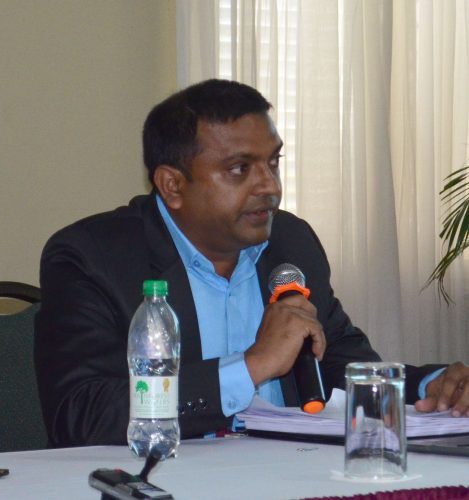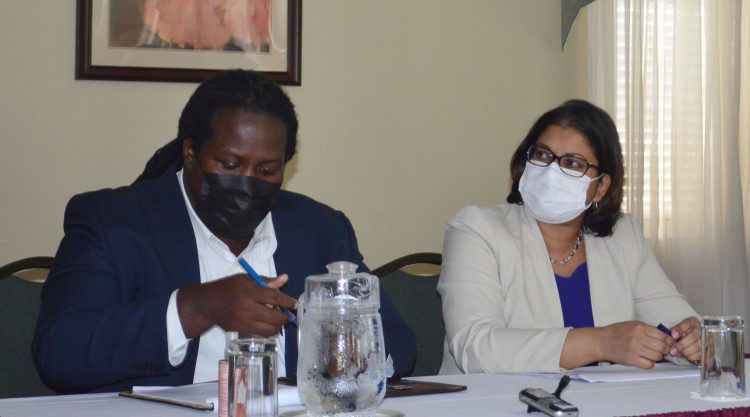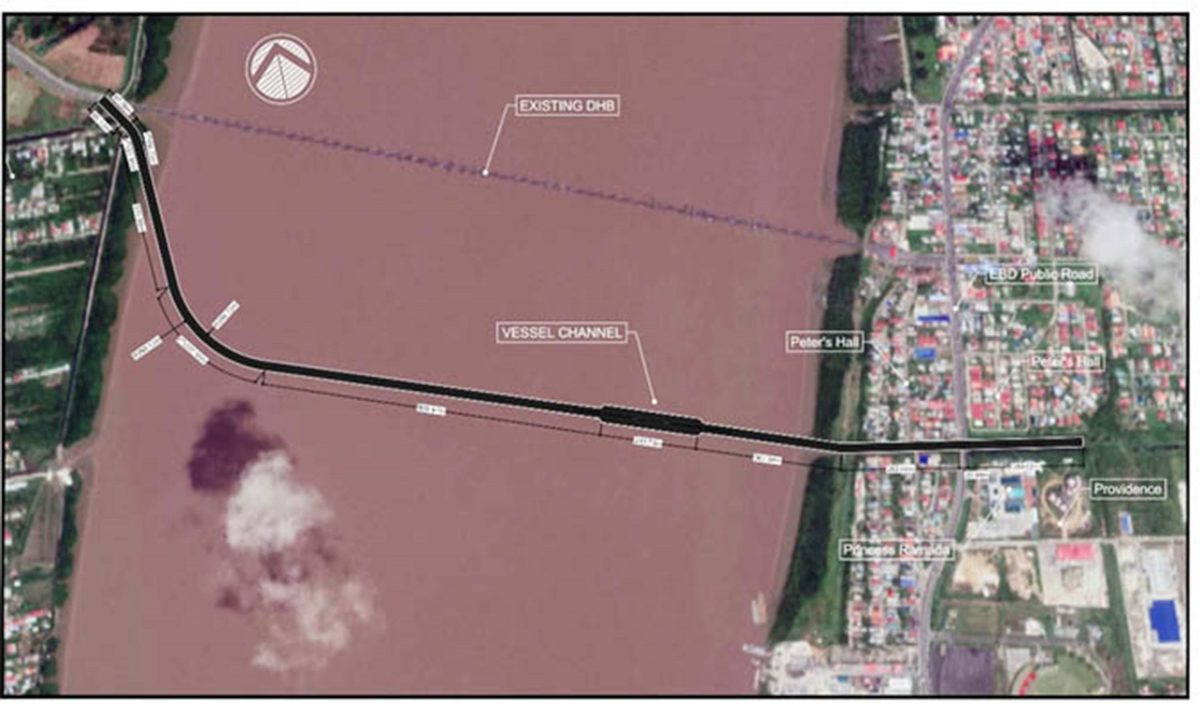The Environmental Assessment Board (EAB) yesterday heard that there were “fatal gaps” in the EPA’s decision to waive an impact study for the new Demerara Harbour Bridge and it was urged to overturn it.
Environmentalist Simone Mangal-Joly was named as the only appellant and presented her own arguments. The hearing was presided over by EAB’s Chair Pradeepa Bholanath and members Dr Garvin Cummings and Joslyn McKenzie.
The trio is tasked with determining whether the Environmental Protection Agency’s (EPA) decision to waive the environmental impact assessment (EIA) was made using sound data or should be reversed.

Observers have pointed out that the EAB members are all employees of the government. Bholanath is the Senior Director for Climate and REDD+ (Reduc-ing Emissions from Deforestation and forest Degradation) in the Ministry of Natural Resources while McKenzie is the Permanent Secretary of the same ministry. Dr Cummings is the Agriculture Minis-try’s Chief Hydrometeorological Officer.
The current administration has made it clear that it wants the bridge built speedily but this has seen a number of delays and gross inconsistencies by the EPA. The EPA first said in November 2020 that an EIA was necessary and then inexplicably reversed itself nine months later.
In November of last year, the EPA restarted the process for public objections to its decision not to require an environmental impact study. In explaining its decision, the EPA reasoned that even though protected mangroves will have to be removed the impacts are certain to occur but the risks are considered manageable and as such proposed mitigation measures.
The design of the bridge has not yet been made publicly available since the government is still wrapping up negotiations with the potential contractor. Mangal-Joly, who is also a geologist, has been consistently arguing that without the design of the new bridge, the EPA is in no position to decide on its impact.

In early November last year, the Irfaan Ali government announced the selection of China State Construction Engineering Corporation (CSCEC) to build the bridge for US$256,638,289. In its tender document, CSCEC submitted the cost based on the Design, Build and Finance (DBF) option, or Design, Build, Finance, Operate and Maintain (DBFOM).
Government has since moved on to the next contractor, China Railway Construc-tion Corporation International Limited which is in a joint venture with China Railway Caribbean Company Limited and China Railway Engineering Company Limited. Earlier this month, Public Works Minister Juan Edghill told Stabroek News that government is anticipating closing the deal soon. It is unclear whether an agreement has been reached since the government is yet to announce one.
Mangal-Joly submitted her appeal on December 20, 2021, and argued that the EPA’s conclusion that the environmental impacts would not be significant is irrational since the design for the bridge is non-existent.
The hybrid hearing was held yesterday at Cara Lodge in Quamina Street, Georgetown. EAB’s Chair Bholanath said that the Board received one formal appeal in response to the EPA’s public notice notifying of its decision not to require an EIA for the project.
“The EAB under Section 18 (2) (a) of the EP Act 1996 states that that the EAB shall conduct public hearings into all appeals submitted to it under Section 11 (3) (a) of the same act. Further, as per Section 11 (3) (a) of the EPA Amendment Act of 2005, it states that any person who may be affected by a project exempted under Section 2 (a) may lodge an appeal with the Environmental Assessment Board established under Section18 within 30 days of the date of publication of the Agency’s decision. It is the view of the Board that the appeal is in accordance with Section 11 (3) (a) of the Act. Therefore, this public hearing is being convened for that matter.
“It is the intention as part of this public hearing we will deal specifically with the concerns of the appellant against the decision of the EPA not to require an ESIA [Environmental and Social Impact Assessment]. As per Section 11 (3) (a) as well, the EAB shall, within a reasonable time, publish a decision confirming or setting aside the Agency’s decision,” Bholanath told the hearing.
Vicinity
The new bridge is expected to land in the vicinity of Nandy Park on the eastern side of the Demerara River and at La Grange/Meer-Zorgen on the West Bank. Based on the information provided, the bridge is expected to land some 700 metres inland from the eastern bank of Demerara and will be elevated 50 meters at the beginning of the channel – which is closer to the east bank. The descent is slated to be at a rate of 5%.
The Scope of Works in the design/build contract included the complete design and construction of a two-lane dual (four-lane) carriageway, hybrid cable-stayed centre-span bridge with concrete box/T-beam girder approach bridge structures, and must include bridge collision protection, a navigation span to accommodate Handymax vessel navigation aids, lighting, signage, and all other ancillary works, an access road with a minimum of 50 meters up to abutments, toll-collection buildings and ancillary buildings on the West Bank of the Demerara River.
Arguing for the EIA to be required, Mangal-Joly said that the purpose of the study is to identify specific impacts on different receptors in the environment and different categories of stakeholders (differently affected), assess those impacts and then determine their acceptability and any mitigation measures. She added that by waiving this, the EPA is denying those who stand to be affected, a guaranteed right to inclusive participation.
“The key reason we are here today is whether or not the EPA made a rational decision when it waived the requirement for an EIA for the new harbour bridge and whether the EAB should reverse that decision…
“I am going to show you that the EPA was not in a position in November 2021 and is still not in a position to waive the EIA on the grounds of sound reasoning and scientific rigour. The fact that this has happened underscores the need now more than ever for an EIA to identify and assess the impacts and those impacts are not overall, they have to do with specifics,” Mangal-Joly argued.
The environmentalist questioned whether the EPA acted properly in the execution of its mandate noting that with the absence of a design, the Agency is “putting the cart before the horse.”
Fatal gaps
Mangal-Joly reminded the hearing that this is the third application for the project that was submitted by the Ministry of Public Works. She noted that it took the EPA only two working days to conclude that an EIA was not required after it received the last application back in November.
In a letter dated March 26 to Executive Director of the EPA Khemraj Parsram, Mangal-Joly said that the information provided to her for the appeal was grossly inadequate since it was just a copy of the Ministry of Public Work’s application for the construction of the bridge. At yesterday’s hearing, she told the EAB that any new information that the Environmental Protection Agency provides would essentially amount to an ambush since they would have withheld that.
Nevertheless, she premised her argument on two “fatal gaps” and pinpointed three examples of the lack of scientific reasoning for waiving the EIA.
“I am going to look at two fatal gaps, one is the failure to look at the hydromorpho dynamic impacts which is when you build a bridge, the most critical area and the second has to do with the phantom feeder road,” she informed.
The geologist explained that the Demerara River is one that sees very high siltation and when piers are placed in the river it affects the flow of water explaining that it is a profound impact and in the absence of a bridge design this conclusion cannot be drawn.
“When you look at the EPA reasoning it does not address the likely hydrological impacts on the Demerara River. The EPA cannot know these impacts without an impact assessment and you cannot have that without a design for the bridge. This is why the cart is before the horse and why it cannot waive the EIA. It needs to have a married assessment with the design,” Mangal-Joly submitted.
She also argued that the EPA did not consider the road links in its study citing a 2018 Ministry of Public Works study on the substantial increase in vehicular traffic on the Demerara Harbour Bridge. The environmentalist submitted that the EPA cannot know the impacts or assess them in the absence of road designs.
Mangal-Joly said that the EPA failed to deal with the impact of traffic-related air and noise pollution as well.
Substantial screening
The EPA was represented by its head of Projects and Infrastructure Elon Sooknanan who explained the process that it employed before arriving at the decision to waive the impact assessment. He related that the waiving of the impact assessment does not mean that the project has yet been approved adding that an Environmental Social and Management Plan would be needed.
In a statement after the hearing, the EPA sought to further address some of the points made during the presentations. It argued that all of its actions are guided by the Environmental Protection Act and that it is the only agency with the authority to grant or withhold an environmental permit for proposed or existing development projects. The statement related that a heavy amount of screening is involved in arriving at its decisions and reasons are provided as justification for decisions taken.
In its reasoning for waiving the EIA for this project, the Agency concluded that the overall significance of environmental impacts of this project is considered to be low to medium and manageable from a technical, social and financial point of view. The overall social impact of the project will be positive.
Responding directly to questions on missing information in the project summary, raised at the hearing by attendees, the EPA said that the project summary was not the only document it relied on to come to a conclusion.
During his presentation, Sooknanan related that the agency relied on a more than four-year-old feasibility study conducted by Lievense CSO Engineering Contracting along with other standards. That study was mired in controversy since the contract had breached procurement laws among other issues.
Responding to Mangal-Joly’s assertion that the EPA did not consider the feeder roads, Sooknanan noted that many of the supporting road works have been approved or are in the process of being approved by the Agency. He also said that the various aspects of pollution were also considered during the screening process.
Former Public Infrastructure Minister David Patterson was also at the hearing and questioned Sooknanan on the agency’s reliance on the Lievense Report and how old was the data. However, the question was glossed over by the EPA representative.
During his presentation, Sooknanan maintained that the risks to the environment are manageable. He also told the hearing that the EPA has been relying on studies conducted by the National Drainage and Irrigation Authority and the Central Housing and Planning Authority in informing its decision on the project.
The Ministry of Public Work’s Chief Transport Planning Officer Patrick Thompson made a presentation on the bridge. He told the hearing, during questioning, that the design of the bridge is not yet finalized since a contract has not been signed.
The EAB will now deliberate on the information presented by both the EPA and the appellant – in this case, Mangal-Joly before it communicates its decision on whether to uphold or set aside the agency’s waiving of the impact assessment.






